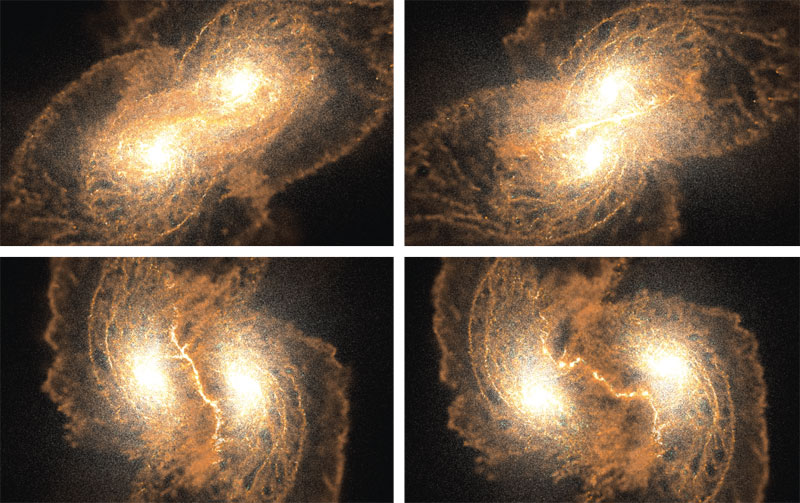Envisioning Cosmic Collisions
By Catherine Clabby
Two scientists simulate the collision of galaxies, with brilliant results
Two scientists simulate the collision of galaxies, with brilliant results

DOI: 10.1511/2009.81.494
Galaxies don’t always keep to themselves. With enough time and gravitational attraction, two can collide and merge. Such events compress clouds of gas that can turn into nurseries for new stars. But few computers, even supercomputers, can handle the calculations needed to simulate this with decent resolution. The challenge rests with the huge number of n-body problems which are needed to predict gravitational forces and involve an enormous number of objects in both galaxies. Special-purpose computers created at the Center for Computational Astrophysics at the National Astronomical Observatory of Japan tackle the job, however. These GRAPE, or “GRAvity PipE,” systems use customized hardware to calculate just the gravitational forces between particles, and host computers to do the rest of the ciphering. Astronomer Takayuki Saitoh used software he designed and a GRAPE-7 system to simulate the collision of two galaxies, each about one-tenth the size of the Milky Way. Takaaki Takeda, an astronomer and visualization expert, is creating animated movies from the numerical-simulation results. In an e-mail exchange, Saitoh and Takeda explained the project to American Scientist associate editor Catherine Clabby.

Takayuki Saitoh and Takaaki Takeda
A. S. What can the GRAPE computers accomplish that others cannot?
T. S. GRAPE supplies a huge calculation power for self-gravity. Actually, GRAPE is about one to two orders of magnitude faster in calculation speed compared to ordinary CPUs. In the galaxy merger simulation, we obtained a large gain in calculations. Moreover, we used a cluster of GRAPEs in order to obtain further accelerations in our simulation. We performed simulations using 100 million particles, 1000 times the number of particles used with simulations on ordinary computers. We always want to increase the particle numbers. The more particle numbers increase, the more we can obtain realistic behavior of merging galaxies.
A. S. What was the most important difference between this simulation and earlier simulations?
T. S. Our merger simulation for the first time incorporates a realistic gas with a wide temperature range. As a result, we successfully reproduced a shock-induced starburst (an area with a large enhancement of star formation within a short duration) during the first encounter. This was widely expected in galaxy mergers but did not appear in previous numerical simulations. In addition to the shock-induced starbursts, we also found many star clusters between the two galaxies. This was the first direct detection of the star-cluster formation process in interacting galaxies. We were strongly surprised by this finding. Now we are investigating mechanisms of star cluster formation in merging galaxies.
A. S. What surprised you most in the animated images you produced from the numerical simulation?
T. T. When the first movie came up, I was impressed that as the galaxies get closer and compress, a dense gas region emerges and evolves. In the animation, it looks as if it is boiling. We know that our view can be affected by visualization parameters such as coloring or density enhancement. However, the animation gives us much information and insight into the movement of materials. Very dense regions are formed at the boundary of two galaxies, and these shock regions make very complicated patterns. When I sent the animation to Saitoh-san, he said: “Oh, we can see the star cluster formation at the shock region, can you zoom up to these clusters?” When I made new movies with a close-up camera, star formation processes appeared clearly!
A. S. What questions did this prompt?
T. S. The question that immediately came to my mind was “how did these star clusters form?” I’m now investigating this point. Furthermore, if the star cluster formation takes place in the shocked region, are the collision geometries (angles of the galaxy disks) important for the formation of star clusters? Collaborators and I are now performing simulations with a wide parameter range and are confirming that there is no prominent enhancement of star formation and no star cluster during the first encounter if the disks are largely tilted.
A. S. Eventually, the National Observatory of Japan will post at least portions of the animation on the Internet for public view, where other animations are already posted. What is the goal of such outreach?
T. T. Visualization images or movies are useful research tools for understanding observational data and computer simulations. They are also good tools to present the latest research results to the public because they are fun and easy to understand. Visualization movies teach what astronomers are interested in and what astronomers are doing to solve the mysteries of the universe.
In Sightings, American Scientist publishes examples of innovative scientific imaging from diverse research fields.
Click "American Scientist" to access home page
American Scientist Comments and Discussion
To discuss our articles or comment on them, please share them and tag American Scientist on social media platforms. Here are links to our profiles on Twitter, Facebook, and LinkedIn.
If we re-share your post, we will moderate comments/discussion following our comments policy.